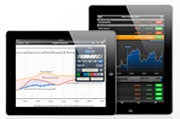The MHL standard allows for turning a mobile device into a full-featured home entertainment and presentation system when coupled with an HDTV. (Credit: Dong Ngo/CNET)
Around about this time in 2010, I blogged about WHDI and its potential to change the way we entertain ourselves in a big way when this wireless display is implemented in mobile devices. Now a year later, that reality is still in the distant future.
Fortunately, there's something else to take its place. It's already here, and chances are your phone and HDTV at home come with it. It does require a wire, however, but that's a good thing.
The technology in question is called MHL, short for Mobile High-Definition Link (it definitely deserves a better name than that), which is a mobile audio/video interface standard for directly connecting mobile phones and other portable consumer electronics devices to high-definition televisions and displays. If you haven't heard of it, that's because it's quite new, first introduced in June of last year.
Unlike wireless display technologies that are fragmented with multiple standards, such as WHDI, Intel's WiDi, and Wi-Fi-based WirelessHD, the MHL Consortium was founded by major electronics vendors: Nokia, Samsung, Silicon Image, Sony, and Toshiba. In addition, it's currently adopted by a long list of major hardware vendors. This explains the wide adoption of the standard, considering its young age. Chances are your Android-based phone and HDTV at home already has it built-in, if they were released this year.
In a nutshell, here's how MHL works: with an MHL-enable device, all you need is an MHL cable. One end is the regular Micro-USB that fits into the charging/syncing port of the phone, and the other end fits in an HDMI port of an HDTV. When the mobile device is connected to an HDTV via the cable, it will mirror the display onto the big screen, with a resolution up to 1080p and 7.1 surround sound. And that's not all.
MHL offered me a demo yesterday, using the Samsung Galaxy II, one of many current smartphones that has built-in support for MHL, with a few HDTVs, including both those that have MHL built-in and those that don't. After the demo, I was sold to the point that now I am contemplating moving to Android from my current iPhone 4.
During the demo, once the Galaxy II was connected to an MHL-enabled TV, it immediately mirrored its screen to the big display. This means, apps (including games), high-def movies, music, photos, and so on look bigger and clearer. And best of all, I was able to use the TV's remote control to navigate the phone, even when the phone was behind the TV, out of sight.
According to Tim Wong, MHL Consortium president, the MHL standard allows any MHL-enabled TVs' remote control to work with the connected portable devices. In the demo, this literally turned the Samsung Galaxy II into a full-featured media player, from which users could stream Netflix or movies stored in a network storage device, or video captured by the phone itself.
Apart from the TV's remote control, Wong also used a Bluetooth keyboard and mouse, which works with any Bluetooth-enabled smartphone, to turn the Galaxy II into a workstation on which he could display presentations, surf the Web, and so on.
Now your question may be how this affects the phone's battery life. Well, you can use the phone this way indefinitely since the MHL cable will also charge the phone at the same time. And it's likely that future HDTVs will come with flexible docking stations that allow you to dock the MHL-enabled mobile device on it, for charging purpose at first, and then perhaps to turn on the TV to watch news or browse YouTube. "With this flexibility, there's endless implementation of MHL. Think about airplanes, cars, even elevators, and so on. You can just plug the phone in and you're all set," Wong said.
MHL works with other non-MHL TVs and displays, too, as long as they have an HMDI port. In this case, you'll need a small adapter, such as the the Kanex adapter, which is available right now for around $20.
Note that some HDTVs, especially those released in 2011, might already have MHL and only need a firmware update to turn that on. The Samsung UN46D7000, for example, doesn't support MHL with its initial firmware but the latest version will add the support.
For now, you'll find support for MHL in most, if not all, recent and new products coming out from the founding vendors, as well as many others on the list of adopters. As for Apple, it's unclear if the company is onboard. According to Wong, it's totally possible to make MHL support other port configurations, other than the standard Micro-USB, such as the 32-pin of the iOS devices. I hope that the next iPhone will have support for this standard. "You already carry your whole life on your hip, why not make it more interesting?" Wong asked. Exactly, why not, Apple?
http://news.cnet.com















